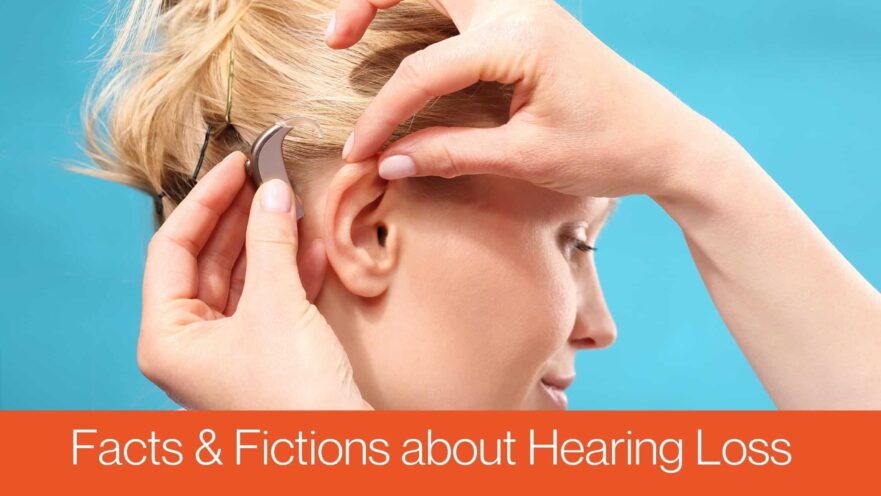Over the last ten years, there has been a significant increase in public awareness about hearing health. However, there are a few typical misunderstandings that refuse to go away.
Hearing loss tends to have a hidden quality since it takes so long to occur. However, the risk of hearing loss is genuine, and once it occurs, it cannot be reversed. That is why we must remain alert in monitoring its progress and dispelling falsehoods as they emerge.
The following are some of the most popular hearing loss myths.
Myth #1: Hearing loss only comes from loud noise
Hearing loss is caused by aging, which is the most prevalent cause. This cause of hearing loss is known as presbycusis, and it’s caused by a change in the ear’s structure as we get older.
Genetics, drugs, smoking, a poor diet, and diabetes are among the other risks. These factors can harm hair cells, which are essential for transmitting auditory impulses to the brain. These hair cells can’t be regenerated naturally or through therapeutic techniques once they cease performing.
Myth #2: Only older adults need to worry about hearing loss
Although we indicated that hearing loss is most commonly caused by aging, this does not mean that younger generations are immune. Hearing loss can occur gradually or unexpectedly at any time in your life.
Hearing loss can be caused by a variety of factors that are unrelated to age. However, one of the more pressing causes is hearing loss caused by long-term noise exposure. With the widespread usage of smartphones and earphones, younger generations must use their smartphones responsibly to protect their future hearing.
Myth #3: You would be able to understand others if only they spoke more clearly
One of the most prevalent complaints of people with untreated hearing loss is that they rely on others to speak out for them. They claim they don’t have hearing loss because they can hear people but can’t understand what they’re saying because of the muttering.
This argument is based on a fundamental misunderstanding of the mechanics of hearing loss. Hearing loss is not uniform across all frequencies. The frequencies with the highest frequencies are the first to perish. Because many of the crucial consonant sounds are in these upper registers, it might be challenging to discern between different words when the capacity to hear those consonants is lost. For example, ‘cat’ vs. ‘sat.’
This difficulty is exacerbated in noisy surroundings, where the lower frequency background noise sounds louder than the higher-frequency sounds of your friend’s voice.
This is why hearing loss makes it harder for people to hear others in noisy situations. The latest hearing aids, fortunately, can lower background noise while increasing the frequencies required to hear speech.
Myth #4: Only severe hearing loss needs treatment
It will be more difficult to treat hearing loss if you play the waiting game. The auditory system in your brain begins to lose its ability to recognize the sound as it is utilized less and less. As a result, hearing aids will be less effective.
Because of the recent discovery of the brain’s “neuroplasticity,” treating hearing loss rehabilitates that region of the brain, allowing it to relearn how to hear. Your auditory system’s capabilities can be restored faster if you treat hearing loss early.
Myth #5: Hearing loss doesn’t affect other parts of my health
This is untrue. It can have a significant impact on your health. Untreated hearing loss has been related to fatigue, sadness, stress, anxiety, social isolation, lower productivity, a loss of physical independence, and dementia in numerous studies.
Myth #6: Hearing aids are like glasses
When you finally obtain glasses after such a long time without them, the difference is striking. Vision can be instantaneously corrected to 20/20 with the right prescription. Unfortunately, many individuals still believe that hearing aids are the same. After all, aren’t they both gadgets that help us sharpen our senses? Hearing loss sufferers will be disappointed by the reality.
Hearing aids take an average of 6 weeks for a person to notice the improvements, and this is with everyday use. Hearing is as much a function of the brain as it is of the ear. Thus it takes time for the brain to acclimate to the sound coming through the hearing aid. It can also take a long time to properly fit hearing aids, necessitating frequent visits to the audiologist. In the end, the numerous advantages that hearing aid users experience make it worthwhile to invest the time and effort.
Are you considering having your hearing loss treated? Why not make an appointment with us for a hearing evaluation today?

